Energy Solutions
Nothing - no one energy source - is a "panacea" in itself. Can't we all agree on that? Nevertheless, we seem to continue to publish commentaries and papers that insist on attacking a premise that no one asserts! Namely, I'm not familiar with anyone, not even Boone Pickens, who says that natural gas will solve all our energy challenges. Yet, the first premise attacked by most critics is that someone has said that natural gas is a panacea, or that natural gas can make us energy independent. Likewise about additional drilling - it's not a panacea, and it won't ever make us energy independent, but we need to do it!
We need to develop every sensible energy option we have - even fossil fuel ones - while we work on ramping conservation, researching and developing alternatives and transitioning our how we live, work and eat. It will take a while - Dr. Hirsch said 10 to 20 years. Why must we continue to develop fossil fuels, and even deploy natural gas in vehicles in the meantime, during the transition? Because vehicles and fossil fuels are too ingrained in every thing we are, and in every thing we do. We just can't change that overnight - we can't stop using them one day, and shift to alternatives the next. In the meantime we've got to develop oil and gas reserves faster in order to compensate for the smaller discoveries that characterize the right hand side of Hubbert's Curve. "Saving" the reserves for a rainy day is noble thought, but not realistic with the serious situation we face. So if we choose to marginalize and destroy our oil and gas infrastructure - we will see what "Hubbert's Cliff" looks like, due to accelerating depletion. I suspect that the accompanying scenario would make Mr. Kunstler's novel look like a walk in the park.
Let's take this opportunity to unite our country, not divide it with a "fossil fuels bad, only alternative energy good" mentality. We'll be more "postcarbon" with every passing year - but we need to get on with the transition, quit bickering and pointing fingers while we continue to wisely develop and use the resources we have to get there as soon as possible.
MIT gas paper
http://web.mit.edu/mitei/research/studies/naturalgas.html
Video of the BP relief well effort
Currently there are a bunch of fine men and women working real hard, using billions of dollars of state-of-the-art equipment and techniques to control this blowout. Take a look at this video regarding the drilling of the relief well:
http://bp.concerts.com/gom/kwellsreliefwells062710.htm
Those of us in the “Peak Oil Community” - as it is called - believe that Peak Oil will lead to a paradigm shift on the order of the Industrial Revolution. And we generally believe that Peak Oil is “upon us”. But with substantial challenges, come substantial opportunities …
Monday, June 28, 2010
Saturday, June 5, 2010
How to Use Less Oil (and why we must keep drilling)
As we have learned recently, oil can make quite a mess. Nevertheless, oil is a wonderful substance. The world's endowment of oil is/was largely responsible for sponsoring many of the advancements that have brought sufficient food and longer, easier lives to many in the world. Yes, oil has also sponsored "excess", but that is in the process of correction. Oil's highest and best use is not in burning it as a fuel. As Kenneth Deffeyes said in Hubbert's Peak, someday our grandchildren will ask/exclaim, "You burned all those wonderful molecules?!"
Since about 70 percent of the oil consumed in the USA is used for transportation, "Peak Oil" is really a transportation issue (initially, at least). It would be wonderful to be able to snap our fingers and have electric car or PHEV replacements (where applicable), but the electrical storage issues are still not resolved (lithium supplies for batteries, or a new technology), so production and replacement can't yet take place on a large scale.
The bottom-line is that we must have sufficient fossil fuels as we transition. And we will have to maintain a substantial level of oil and gas exploration and development activity - in fact an increased level of activity - as the law of diminishing returns takes over on the right hand side of Hubbert's Curve. If we continue to follow what seems like the vogue path of seeking to marginalize our fossil fuels industry, Hubbert's Curve will transform into Hubbert's Cliff, with even more catastrophic results at all levels of society and the economy. Such talk and action also drives a divisive stake into the heart of our nation. Fossil fuels or "clean", alternative energy? The reality is, as we transition over the next 20 years or so we will need substantial quantities of fossil fuels AND ramped-up conservation and alternative energy sources. In 40 years we will still need fossil fuels, but far less will be available. So, we must preserve and even enhance our fossil fuel infrastructure even as we ramp up alternative energy sources and implement substantial conservation.
Currently our nation and the world have a substantial endowment of recoverable natural gas. Natural gas emits half the carbon of coal, when burned. Further, natural gas can be used directly in vehicles, with fairly easy conversions using existing technology. Natural gas can also be a carbon-neutral, renewable fuel when it is produced from waste biomass (manure, landfills, etc.). So, given the impending oil shortage (currently masked by the economic downturn), and while we wait on electrical storage advances, it makes sense to convert a portion of our truck fleet, bus fleet and our passenger cars - to natural gas. If you want to see a lot of natural gas vehicles in action, just go to Italy, or Bolivia.
In an effort to continue to try to explain "Peak Oil", and also to make the case that natural gas is a suitable transition fuel for vehicles, the following presentation was developed for and delivered to the Gulf Coast Association of Geologic Societies, at their annual convention on September 27, 2009:


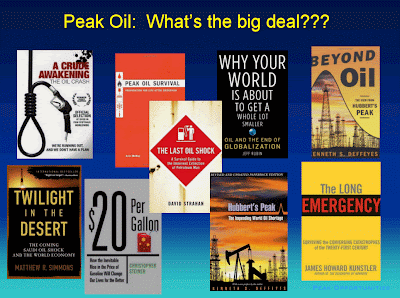



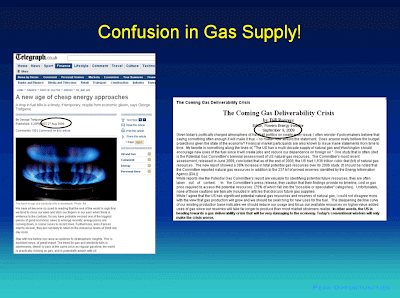

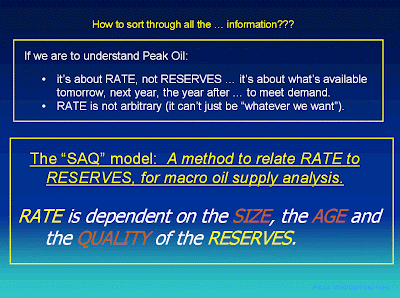
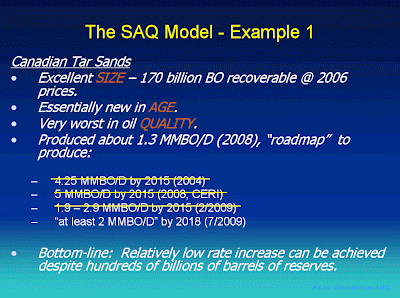

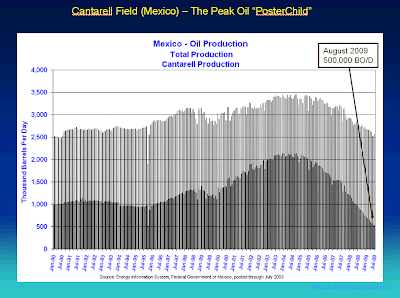


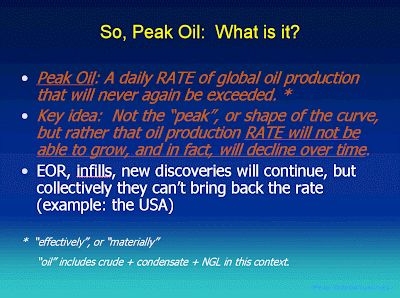
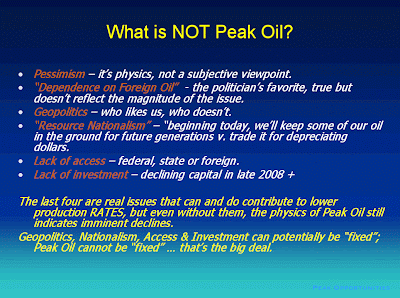
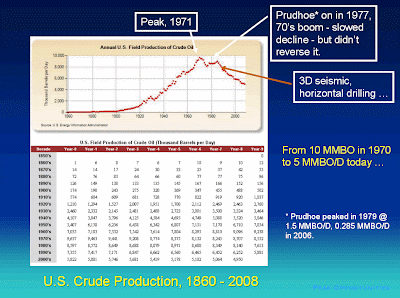
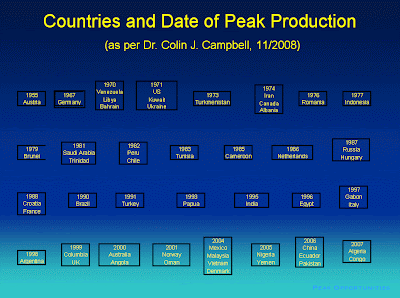


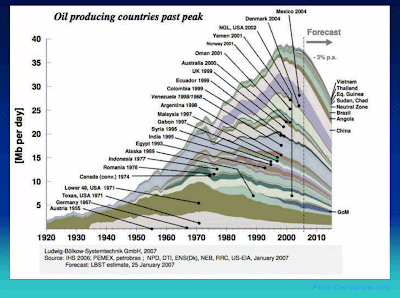



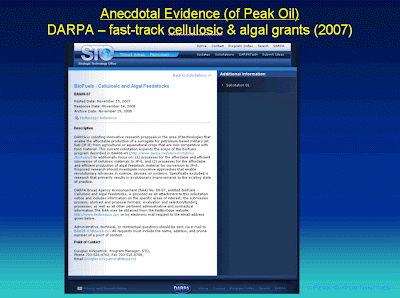



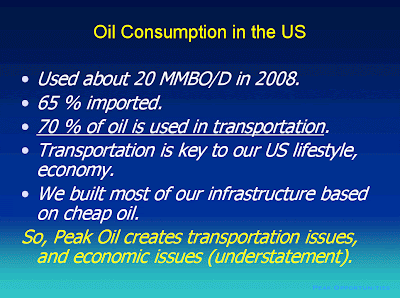

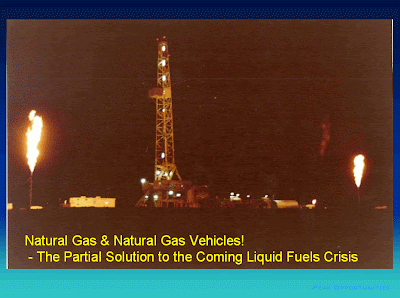


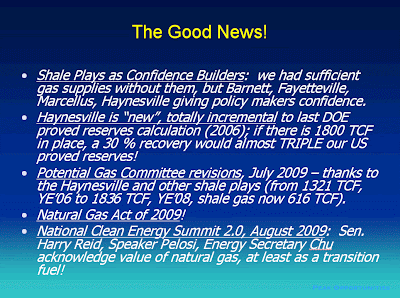
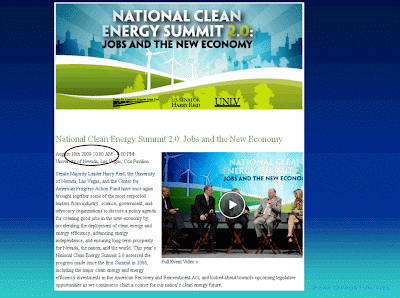

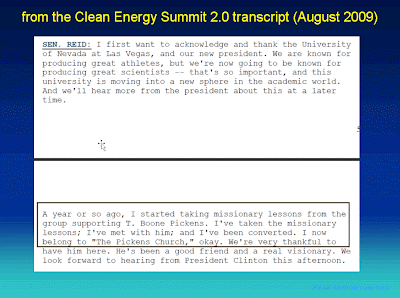





Since about 70 percent of the oil consumed in the USA is used for transportation, "Peak Oil" is really a transportation issue (initially, at least). It would be wonderful to be able to snap our fingers and have electric car or PHEV replacements (where applicable), but the electrical storage issues are still not resolved (lithium supplies for batteries, or a new technology), so production and replacement can't yet take place on a large scale.
The bottom-line is that we must have sufficient fossil fuels as we transition. And we will have to maintain a substantial level of oil and gas exploration and development activity - in fact an increased level of activity - as the law of diminishing returns takes over on the right hand side of Hubbert's Curve. If we continue to follow what seems like the vogue path of seeking to marginalize our fossil fuels industry, Hubbert's Curve will transform into Hubbert's Cliff, with even more catastrophic results at all levels of society and the economy. Such talk and action also drives a divisive stake into the heart of our nation. Fossil fuels or "clean", alternative energy? The reality is, as we transition over the next 20 years or so we will need substantial quantities of fossil fuels AND ramped-up conservation and alternative energy sources. In 40 years we will still need fossil fuels, but far less will be available. So, we must preserve and even enhance our fossil fuel infrastructure even as we ramp up alternative energy sources and implement substantial conservation.
Currently our nation and the world have a substantial endowment of recoverable natural gas. Natural gas emits half the carbon of coal, when burned. Further, natural gas can be used directly in vehicles, with fairly easy conversions using existing technology. Natural gas can also be a carbon-neutral, renewable fuel when it is produced from waste biomass (manure, landfills, etc.). So, given the impending oil shortage (currently masked by the economic downturn), and while we wait on electrical storage advances, it makes sense to convert a portion of our truck fleet, bus fleet and our passenger cars - to natural gas. If you want to see a lot of natural gas vehicles in action, just go to Italy, or Bolivia.
In an effort to continue to try to explain "Peak Oil", and also to make the case that natural gas is a suitable transition fuel for vehicles, the following presentation was developed for and delivered to the Gulf Coast Association of Geologic Societies, at their annual convention on September 27, 2009:
Statistics and Shale Plays ...
“There are three kinds of lies: lies, damn lies and statistics.”
Mark Twain
Recently it was noted that there are over ten times more bacterial and fungal cells on or in the average human - than there are human cells! (http://en.wikipedia.org/wiki/Human_flora)
As you can see, statistics don’t always tell the whole story. In fact, in this complicated world we can get badly misled if we limit our analyses to simple, reductionist statistics. Statistics can be quite helpful – but only if they are used in parallel with a full and correct understanding of all the available objective and subjective data.
Unfortunately, in this complicated world none of us has time to become “expert” on all things. As a result, we are forced to rely on simplifications or summaries done by others. Problems can ensure if those we are relying on have not gathered and correctly analyzed the requisite data, but instead have made statistical observations based on incomplete data or analyses. Further, in some cases it may not even be possible to come to a correct conclusion – even with all of the available data and the best analysis! The danger of statistics lies (pun intended) in the fact that statistics ALWAYS yield a numerical answer – an answer which may be premature, convoluted or just plain wrong.
So, statistics are not facts at all; rather, statistics are just numbers that may - or may not - represent a realistic analysis of a situation.
The Complexity of Shale Plays
Various rock parameters are required in order for a geographical portion of a given of a shale play to “work”. Just like the rock you see on the side of the road, these parameters vary across an area. We humans tend to subdivide things into convenient, already-existing “buckets”. In the case of land areas, counties are already defined, so we might say Blah County is “good”, and Blah Blah County is “not good”. The fact is, even in a play where 40 counties are “good”, there are always the “edges” - with “edges” representing the transitions between “good” and “not good”.
The noted Marcellus Shale expert, Dr. Terry Engelder of Penn State, has come up with the useful analogy of “toast” to explain the important shale gas geochemical parameter known as thermal maturity (sometimes referred to as Ro or Tm). In his slide show, Dr. Engelder shows partially cooked toast, charred toast, and toast that looks like it was cooked “just right”. The genius of this analogy is that we can all relate to properly cooked toast!
As it turns out, rock parameters don’t necessarily honor the county lines we have drawn. So, on the “edges” of a play part of a county may be perfectly cooked toast, and part of it may be burned toast! How do we find these edges? Sometimes data exists, but often it is spotty or undependable for whatever reason. Sometimes two analysts can look at the same data and come up with two different answers. Sometimes two analysts can come up with … five different answers! Also, rock parameters don’t follow straight lines on a map; they curve around – in here, out there.
So, often we have to find the edges the hard, expensive way - we have to drill multi-million dollar wells. And sometimes even when Company X thinks they know where the edge is, Company Y doesn’t have that same data. So, Company Y may wind up drilling a non-commercial well in an area that Company X had already condemned as “not good”. In this case, Company Y is viewed with disfavor. Given the full alphabet of companies out there, and given the infinitely curvy lines of rock parameters, there can be a lot of failed efforts along an “edge”. All these failed efforts can go into a statistical exercise that views a given portion of a given shale play in a simplistic way. Should the play in general, and Company X in particular, be condemned for the actions of Company Y and its alphabet brethren?
On the other hand, sometimes Company Y may have the same data as Company X, but Company Y thinks the data is suspect, or incomplete, or just has a different interpretation. So, in this case, Company Y takes the risk and drills a successful, multi-million dollar well. Company Y becomes a hero and in fact by extending the play in this direction, Companies Z, A, B - and even Company X - may benefit! Meanwhile, the royalty owners in this new area and the schoolchildren of that state (who sometimes get the benefits from the production taxes paid by Company Y and its royalty owners) become major beneficiaries of Company Y’s “guts”. Such is the nature of the oil and gas exploration business in unconventional shale plays!
Mark Twain
Recently it was noted that there are over ten times more bacterial and fungal cells on or in the average human - than there are human cells! (http://en.wikipedia.org/wiki/Human_flora)
Along comes a statistician, let’s call him Bob. Now Bob went to a good school, he’s a good public speaker, and he keeps his shoes shiny. All-in-all, Bob is a pretty credible guy. Bob works with a fellow named Billy Red. Billy’s a good guy too, but he’s in the kangaroo business and frankly, he’s a little miffed that humans are getting all the attention these days! Nevertheless, Bob is able to maintain his objectivity. Bob looks at the above discovery, does the math again himself, and states his conclusion, “Humans are not humans at all - they are bugs and mold!” “Why do you say that?”, someone asks. “Well, over half the cells on the subjects analyzed are bugs and mold, so therefore humans must be … bugs and mold!”, Bob replies.
Bob goes on to say, “Look, I wish it weren’t so. All I do is look at the FACTS. I’d be happy to go over this with anyone. I truly wish I was wrong.” What could be more reasonable?
Along comes Sam. Sam is a noted biologist with a long, distinguished career. In fact, Sam is currently director of the biological survey for his adopted state. Sam’s state mainly has birds, not humans. Over the years though, Sam has known a few humans and he’s found them, well … a little weird! Sam’s impressed with Bob, and believes he’s telling the truth. Sam recommends Bob and Bob’s work, and he goes on to exclaim, “Y’all better pay attention to what Bob has to say.” And so it goes that Bob’s credibility grows, and it’s not looking good for humans remaining to be classified as humans …
Who’s telling the truth here? What are the facts? Are humans, humans? Or are they bugs and mold?
Bob goes on to say, “Look, I wish it weren’t so. All I do is look at the FACTS. I’d be happy to go over this with anyone. I truly wish I was wrong.” What could be more reasonable?
Along comes Sam. Sam is a noted biologist with a long, distinguished career. In fact, Sam is currently director of the biological survey for his adopted state. Sam’s state mainly has birds, not humans. Over the years though, Sam has known a few humans and he’s found them, well … a little weird! Sam’s impressed with Bob, and believes he’s telling the truth. Sam recommends Bob and Bob’s work, and he goes on to exclaim, “Y’all better pay attention to what Bob has to say.” And so it goes that Bob’s credibility grows, and it’s not looking good for humans remaining to be classified as humans …
Who’s telling the truth here? What are the facts? Are humans, humans? Or are they bugs and mold?
As you can see, statistics don’t always tell the whole story. In fact, in this complicated world we can get badly misled if we limit our analyses to simple, reductionist statistics. Statistics can be quite helpful – but only if they are used in parallel with a full and correct understanding of all the available objective and subjective data.
Unfortunately, in this complicated world none of us has time to become “expert” on all things. As a result, we are forced to rely on simplifications or summaries done by others. Problems can ensure if those we are relying on have not gathered and correctly analyzed the requisite data, but instead have made statistical observations based on incomplete data or analyses. Further, in some cases it may not even be possible to come to a correct conclusion – even with all of the available data and the best analysis! The danger of statistics lies (pun intended) in the fact that statistics ALWAYS yield a numerical answer – an answer which may be premature, convoluted or just plain wrong.
So, statistics are not facts at all; rather, statistics are just numbers that may - or may not - represent a realistic analysis of a situation.
The Complexity of Shale Plays
Various rock parameters are required in order for a geographical portion of a given of a shale play to “work”. Just like the rock you see on the side of the road, these parameters vary across an area. We humans tend to subdivide things into convenient, already-existing “buckets”. In the case of land areas, counties are already defined, so we might say Blah County is “good”, and Blah Blah County is “not good”. The fact is, even in a play where 40 counties are “good”, there are always the “edges” - with “edges” representing the transitions between “good” and “not good”.
The noted Marcellus Shale expert, Dr. Terry Engelder of Penn State, has come up with the useful analogy of “toast” to explain the important shale gas geochemical parameter known as thermal maturity (sometimes referred to as Ro or Tm). In his slide show, Dr. Engelder shows partially cooked toast, charred toast, and toast that looks like it was cooked “just right”. The genius of this analogy is that we can all relate to properly cooked toast!
As it turns out, rock parameters don’t necessarily honor the county lines we have drawn. So, on the “edges” of a play part of a county may be perfectly cooked toast, and part of it may be burned toast! How do we find these edges? Sometimes data exists, but often it is spotty or undependable for whatever reason. Sometimes two analysts can look at the same data and come up with two different answers. Sometimes two analysts can come up with … five different answers! Also, rock parameters don’t follow straight lines on a map; they curve around – in here, out there.
So, often we have to find the edges the hard, expensive way - we have to drill multi-million dollar wells. And sometimes even when Company X thinks they know where the edge is, Company Y doesn’t have that same data. So, Company Y may wind up drilling a non-commercial well in an area that Company X had already condemned as “not good”. In this case, Company Y is viewed with disfavor. Given the full alphabet of companies out there, and given the infinitely curvy lines of rock parameters, there can be a lot of failed efforts along an “edge”. All these failed efforts can go into a statistical exercise that views a given portion of a given shale play in a simplistic way. Should the play in general, and Company X in particular, be condemned for the actions of Company Y and its alphabet brethren?
On the other hand, sometimes Company Y may have the same data as Company X, but Company Y thinks the data is suspect, or incomplete, or just has a different interpretation. So, in this case, Company Y takes the risk and drills a successful, multi-million dollar well. Company Y becomes a hero and in fact by extending the play in this direction, Companies Z, A, B - and even Company X - may benefit! Meanwhile, the royalty owners in this new area and the schoolchildren of that state (who sometimes get the benefits from the production taxes paid by Company Y and its royalty owners) become major beneficiaries of Company Y’s “guts”. Such is the nature of the oil and gas exploration business in unconventional shale plays!
Subscribe to:
Posts (Atom)